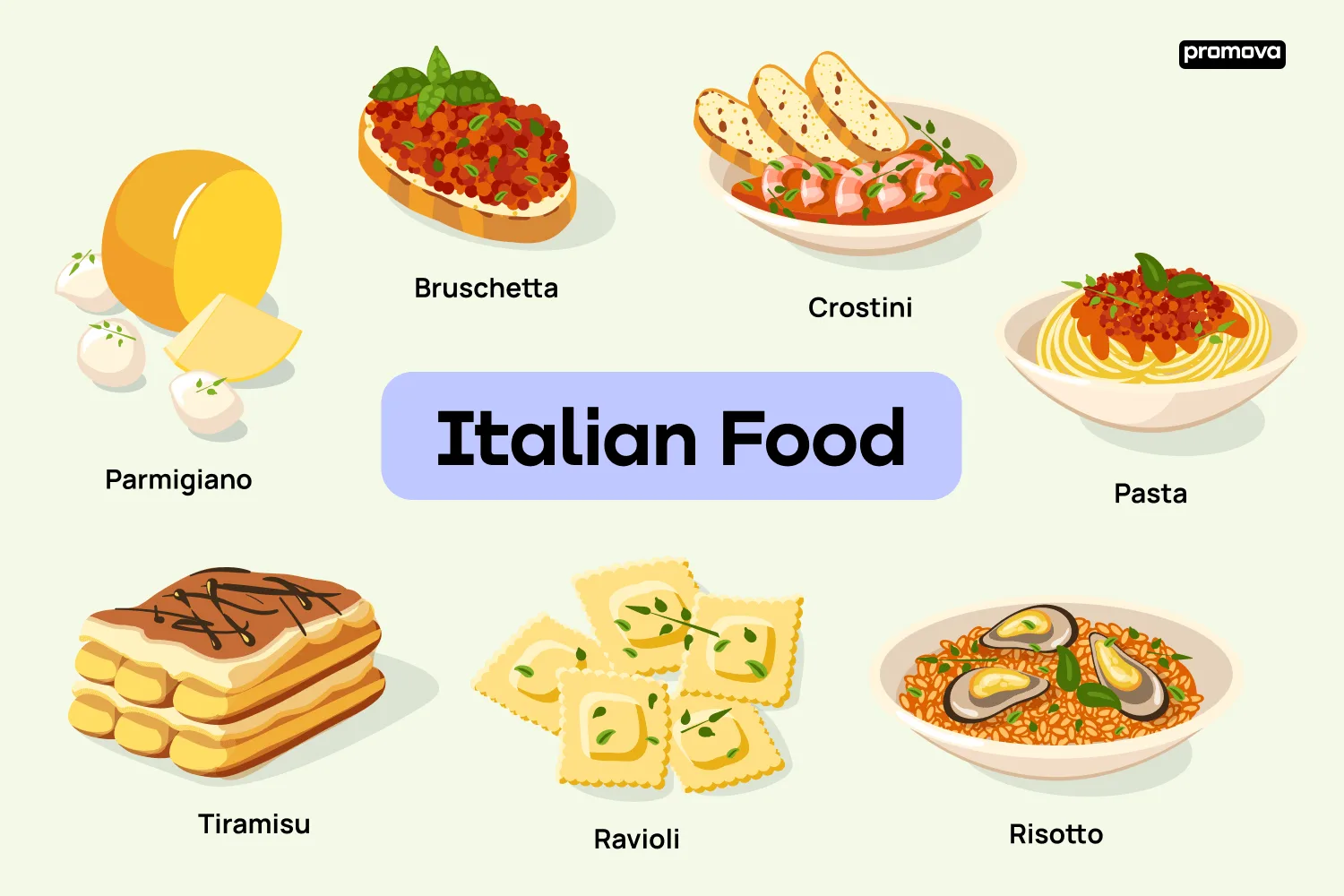Italian cuisine is loved worldwide for its rich flavors and variety. Learning Italian food words can enhance your dining experience and impress your friends.
Imagine savoring a delicious plate of pasta in a cozy Italian restaurant. Knowing the Italian names for different foods can make ordering more fun and authentic. From “pizza” to “gelato,” each word carries a bit of Italy’s vibrant culture. This guide will introduce you to common Italian food words, helping you feel more confident and connected during your next Italian meal.
Dive in and let your taste buds and vocabulary journey to Italy!

Introduction To Italian Food Vocabulary
Italian cuisine is beloved worldwide for its rich flavors and delicious dishes. Understanding some basic Italian food vocabulary can enhance your dining experience. Whether you are visiting Italy or trying out an Italian recipe at home, knowing these terms will help you appreciate the culture and cuisine even more.
Why Learn Italian Food Terms?
Knowing Italian food terms can make your dining experiences more enjoyable. Many Italian menus use original language terms that might be confusing. Here are some reasons to learn them:
- Authenticity: Feel like a local when ordering.
- Understanding: Know what you are ordering.
- Confidence: Order with ease and confidence.
Benefits For Food Lovers
If you love food, learning Italian food terms has many benefits. It opens up a world of flavors and experiences. Here are some benefits for food lovers:
- Enhanced Dining: Enjoy meals more by knowing what each dish is.
- Cooking Skills: Improve your cooking with authentic recipes.
- Cultural Appreciation: Understand the culture behind the food.
| Italian Term | English Translation |
|---|---|
| Antipasto | Starter or appetizer |
| Primo | First course (usually pasta or soup) |
| Secondo | Main course (meat or fish) |
| Dolce | Dessert |
Learning these terms will make your Italian food journey more enjoyable. Buon appetito!
Common Italian Food Words
Italian cuisine offers a delightful array of flavors and traditions. Knowing common Italian food words can enhance your dining experience. Let’s explore some basic terms and everyday ingredients.
Basic Food Terms
Many Italian dishes are known globally. Familiarizing yourself with these terms can be helpful.
Pasta: This term refers to various noodles. Common types include spaghetti, penne, and fettuccine.
Pizza: A baked flatbread with various toppings. Popular options are Margherita and Pepperoni.
Risotto: A creamy rice dish cooked with broth. Ingredients like mushrooms or seafood are often added.
Antipasto: An appetizer. It typically includes meats, cheeses, and vegetables.
Dolce: A term for dessert. Common choices are tiramisu and gelato.
Everyday Ingredients
Italian cooking uses specific ingredients regularly. Learning these can help you understand recipes better.
Olive oil: Used in cooking and dressings. It adds rich flavor.
Garlic: A key ingredient in many dishes. Adds a distinct taste.
Basil: Often used fresh. Common in sauces and as a garnish.
Tomatoes: Essential for sauces and salads. They add sweetness and acidity.
Parmesan: A hard cheese. Grated on pastas and salads.
Italian Pasta Vocabulary
Italian cuisine is known for its delicious and diverse pasta dishes. Learning some Italian pasta vocabulary can enhance your culinary experience. Below, we explore different types of pasta and popular pasta dishes.
Types Of Pasta
Italy offers a wide variety of pasta types. Each type has its unique texture and shape. Here are some common types:
| Pasta Type | Description |
|---|---|
| Spaghetti | Long, thin, and cylindrical. Perfect for tomato-based sauces. |
| Fusilli | Corkscrew-shaped pasta. Great for holding onto thicker sauces. |
| Penne | Tube-shaped with diagonal cuts. Ideal for chunky meat or vegetable sauces. |
| Fettuccine | Flat, thick noodles. Typically paired with creamy sauces. |
| Ravioli | Stuffed pasta pockets. Often filled with cheese, meat, or vegetables. |
Popular Pasta Dishes
Italian pasta dishes are famous worldwide. Here are some must-try dishes:
- Spaghetti Carbonara: Spaghetti with eggs, cheese, pancetta, and pepper.
- Lasagna: Layered pasta with meat sauce, cheese, and béchamel sauce.
- Penne Arrabbiata: Penne pasta with spicy tomato sauce.
- Fettuccine Alfredo: Fettuccine pasta with butter and Parmesan cheese sauce.
- Ravioli al Pomodoro: Ravioli served with a simple tomato sauce.
Learning these Italian pasta terms can make your dining experience more enjoyable. Try using them next time you order pasta!
Italian Cheese Names
Italy is renowned for its delicious cuisine, especially its cheeses. Italian cheese names are as varied as the regions they come from. Each has its unique flavor and texture, making them a delight for cheese lovers. Below, we explore famous Italian cheeses and how to pair them with wine.
Famous Italian Cheeses
Many Italian cheeses are famous worldwide. Parmesan, also known as Parmigiano Reggiano, is one of the most popular. It has a hard texture and a nutty flavor. Often used in cooking, it adds depth to many dishes.
Mozzarella is another well-known cheese. It is soft and has a mild flavor. Fresh mozzarella is often used in salads and pizzas. Its creamy texture makes it a favorite for many.
Gorgonzola is a blue cheese with a strong flavor. It is creamy and crumbly. Gorgonzola adds a bold taste to salads and sauces. It can be sweet or spicy, depending on its age.
Pairing Cheese With Wine
Pairing cheese with wine enhances the flavors of both. Parmesan pairs well with Chianti or Barolo. These wines have a bold taste that complements the nutty flavor of Parmesan.
Mozzarella goes well with light, crisp wines. Try pairing it with Pinot Grigio or Sauvignon Blanc. These wines enhance the fresh, creamy taste of mozzarella.
Gorgonzola pairs best with sweet wines. A good choice is Moscato or Port. The sweetness of the wine balances the strong flavor of the cheese.
Experiment with different pairings to find your favorite. The right wine can make a cheese taste even better.
Italian Meat Dishes
Italian cuisine is famous for its rich flavors and diverse dishes. Italian meat dishes hold a special place in this culinary tradition. These dishes often feature tender, flavorful meats cooked with herbs, spices, and sauces. They offer a hearty and satisfying meal that delights the taste buds.
Traditional Meat Recipes
One classic Italian meat dish is Osso Buco. This dish features braised veal shanks cooked with vegetables, white wine, and broth. The meat becomes tender and falls off the bone. Another beloved recipe is Pollo alla Cacciatora, or “hunter’s chicken.” This dish combines chicken with tomatoes, onions, herbs, and wine for a rich, savory flavor.
Another favorite is Bistecca alla Fiorentina. This Tuscan steak is a thick-cut T-bone, grilled to perfection. Served with just a drizzle of olive oil and a sprinkle of salt, it’s simplicity at its best. Don’t forget Arrosto di Maiale, or roasted pork. This dish often includes garlic, rosemary, and white wine, creating a flavorful and juicy roast.
Regional Meat Specialties
Italy’s regions each have their own unique meat dishes. In Emilia-Romagna, try Cotechino con Lenticchie. This dish features a slow-cooked pork sausage served with lentils. In Sicily, sample Involtini di Carne. These are thin slices of beef rolled with breadcrumbs, cheese, and herbs.
In the northern region of Lombardy, Risotto alla Milanese con Ossobuco is a must-try. This dish pairs saffron-flavored risotto with braised veal shanks. In the region of Umbria, enjoy Porchetta. This is a whole pig stuffed with garlic, rosemary, and fennel, then slow-roasted.
Each Italian meat dish tells a story of tradition and regional pride. Whether you prefer a hearty stew or a simple roast, Italian cuisine offers something for everyone. Enjoy exploring these flavorful dishes!
Italian Bread Varieties
Italian bread is a staple in many households. Each region has its own special bread. Some are famous across the world. Others are hidden gems waiting to be discovered. Let’s explore the world of Italian bread.
Common Breads
Some Italian breads are popular everywhere. These breads are easy to find in many bakeries and grocery stores. Here are a few examples:
- Ciabatta – Known for its crisp crust and airy interior. Perfect for sandwiches.
- Focaccia – A flatbread often topped with olive oil, herbs, and salt. A great snack or side dish.
- Pane Toscano – A traditional Tuscan bread. It has no salt, making it unique.
Unique Regional Breads
Italy has many regions, each with its own unique bread. These breads tell the story of their area. Here are some examples:
| Region | Bread Name | Description |
|---|---|---|
| Puglia | Pane di Altamura | Made from durum wheat, with a thick crust and soft interior. |
| Sardinia | Carta di Musica | Thin and crisp, similar to a cracker. Great with cheese. |
| Liguria | Farinata | A flatbread made from chickpea flour. Often topped with rosemary. |
Italian Dessert Terms
Italian cuisine is famous for its delicious desserts. From creamy gelato to sweet pastries, these treats are loved worldwide. Understanding the Italian terms for desserts can enhance your culinary experience. Let’s dive into some popular and festive Italian dessert terms.
Popular Sweets
Gelato: This is the Italian version of ice cream. It’s creamier and denser.
Tiramisu: A coffee-flavored dessert with layers of mascarpone cheese and cocoa.
Cannoli: Fried pastry tubes filled with sweet ricotta cheese.
Panna Cotta: A creamy dessert made from sweetened cream and gelatin.
Festive Desserts
Panettone: A sweet bread loaf with candied fruits, usually enjoyed during Christmas.
Colomba: An Easter cake shaped like a dove, symbolizing peace.
Zeppole: Deep-fried dough balls often enjoyed during St. Joseph’s Day.
Struffoli: Honey-coated dough balls, usually served around Christmas.

Dining Out In Italy
Dining out in Italy is a delightful experience. The country is famous for its rich culinary traditions. Italians take their food seriously, and this is evident in their dining culture. Knowing a few Italian words for foods can enhance your dining experience. It helps you understand the menu better and communicate with the staff more effectively.
Restaurant Vocabulary
When you walk into an Italian restaurant, the first person you meet is the cameriere (waiter) or cameriera (waitress). They will guide you to your tavolo (table). You might hear them ask if you want acqua naturale (still water) or acqua frizzante (sparkling water). The menu (menu) often lists dishes under categories like antipasti (starters), primi (first courses), secondi (second courses), and dolci (desserts).
Ordering Tips
Ordering food in Italy can be an enjoyable process. Start with per favore (please) and end with grazie (thank you). If you want to order a starter, say “Vorrei un antipasto, per favore” (I would like a starter, please). For a main course, use “Vorrei un secondo, per favore” (I would like a main course, please). If you have dietary preferences, communicate them clearly. For example, “Sono vegetariano” (I am vegetarian) helps in getting the right dish. When you are ready to pay, ask for the conto (bill).

Frequently Asked Questions
What Is The Italian Word For Food Slang?
The Italian word for food slang is “slang alimentare. ” This term encompasses informal and trendy food-related expressions in Italy.
What Do Italians Say For Food?
Italians often say “Buon appetito!” Before eating. They also describe food as “delizioso” (delicious) or “squisito” (exquisite).
What Is The Italian Name For Food?
The Italian name for food is “cibo”.
How Do You Say Yummy In Italian?
“Yummy” in Italian is “buono” for masculine or “buona” for feminine. It means delicious or tasty.
Conclusion
Learning Italian food words can enhance your dining experience. It adds a personal touch. Ordering pasta or gelato in Italian feels special. Plus, it shows respect for the culture. Practice these words often. Soon, you’ll speak with confidence. Enjoy Italian cuisine with newfound knowledge.
Your meals will become more memorable. Happy eating!



